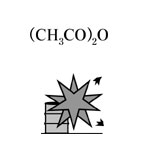| Case Name |
Explosion and fire due to an improper raw material composition during preparation of synthesis of dehydroacetic acid |
| Pictograph |

|
| Date |
October 2, 1967 |
| Place |
Minamata, Kumamoto, Japan |
| Location |
Chemical factory |
| Overview |
An explosion followed by fire occurred during the medium-scale manufacturing experiment of dehydroacetic acid. There is a strong possibility that the unusual reaction was promoted by impurities in the raw material. |
| Incident |
During a medium-scale manufacturing test of dehydroacetic acid, an unusual reaction occurred and led to an explosion and fire. |
| Processing |
Research and Development |
| Process Flow |
Fig2.Unit process flow
|
| Chemical Equation |
Fig3.Chemical reaction formula
|
| Substance |
Acetic anhydride, Fig4 |
| Diketene, Fig5 |
| Type of Accident |
Explosion, Fire |
| Sequence |
A medium-scale manufacturing test of dehydroacetic acid was carried out using a acetic anhydride recovery drum. 1.6 cubic m of raw materials, which contained 80% of crude acetic anhydride, 12% of crude diketene, and 8% NaOH as a catalyst, were charged into a 6 cubic meters reactor using nitrogen pressure. It was heated by dowtherm and the reaction started. 350g of NaOH was added 3 hours after charging raw materials, and a second addition of 500g was carried out after 10 minutes. At about 6 hours after the first charge, as the temperature in the reactor reached 70 °C, the dowtherm boiler was turned off. However, the temperature continued to gradually rise. It reached 86 °C after about 15 minutes, and soon the reactor exploded and fire broke out. The fire spread throughout the factory. |
| Cause |
It was considered that pressure inside the reactor rose due to the temperature rise, which was caused by an unusual exothermic reaction of diketene and acetic anhydride under the presence of alkali. The cause of this unusual reaction was considered as follows.
1. Both diketene and acetic anhydride were used when they came out of the manufacturing process in the factory as a drain without any purification. Therefore, impurities in them might have affected the reaction. In addition, although the diketene concentration in the drain was about 15% in the experiment, it rose to 20% during trial manufacturing.
2. As the recovery drum of acetic anhydride was used as the reactor, a residue adhering in the vessel acted as an impurity.
3. There was a problem in scaling up from the lab scale with beakers and flasks. Besides, the vent piping of 25 mm inner diameter for the exhaust could not fulfill the role of safety equipment. |
| Knowledge Comment |
The previous evaluation of an unusual reaction with impurities is indispensable on handling potentially hazardous materials. |
| Background |
At the R&D stage, investigations and experiments on reaction safety were insufficient. The reason is as follows. Diketene has the property that it readily polymerizes under the presence of alkali. Besides, it was proven by the experiments after the accident that rapid pressure and temperature rising begins after the temperature exceeds 90 °C, to the highest temperature of 169 °C, showing the pressure 1.4 MPaG. The reaction might also be accelerated by a higher concentration of diketen, which was 20% at the medium-scale manufacturing test instead of 15% at the experimental stage. One of the basic purposes of the synthesis experiment was to clarify the composition of the raw materials. First, it should be done with pure materials, and then with industrial grade materials, while the effects of impurities are carefully observed. It seems to be clear that the experiment did not follow the proper procedure due to insufficient management. |
| Reason for Adding to DB |
Example of explosion caused due to a lack of basic knowledge on material hazards |
| Scenario |
| Primary Scenario
|
Insufficient Analysis or Research, Insufficient Prior Research, Insufficient Evaluation of Potential Hazard, Poor Value Perception, Poor Safety Awareness, Insufficient Safety Measure, Condensation Reaction, Planning and Design, Poor Planning, Poor Design, Production, Hardware Production, Diveted Faclity Use, Bad Event, Chemical Phenomenon, Abnormal Reaction, Secondary Damage, External Damage, Explosion, Bodily Harm, Injury, 6 person injured
|
|
| Sources |
Japan Assoc. of Fire Science and Engineering, Chemical fire committee, D.35.2. Diketene. Case 246, Examples of chemical fires (2), p.125(1974)
Masamitsu Tamura, Masahide Wakakura, Explosion and ignition during manufacturing dehydroacetic acid. Reaction danger-Accident case and analysis -p.31(1995)
Ministry of Labor, Industrial Safety and Health Department, Safety section, Explosion and fire caused by unusual reaction in dehydroacetic acid manufacture test. Safety of batch process. pp.44-45(1987)
Ministry of Labor, Labor Standards Bureau, Explosion at intermediate stage test during in-house development. Cases of plant accidents and countermeasures. pp.549-550(1969)
|
| Number of Injuries |
6 |
| Physical Damage |
The reactor was broken into several pieces and was scattered to a distance of 50 to 60 m. Half of the factory collapsed. |
| Multimedia Files |
Fig4.Chemical formula
|
|
Fig5.Chemical formula
|
| Field |
Chemicals and Plants
|
| Author |
ARAI, Mitsuru (Environmental Science Center, The University of Tokyo)
TAMURA, Masamitsu (Center for Risk Management and Safety Sciences, Yokohama National University)
|
|